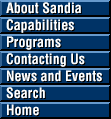|
New Distributed Information Systems Laboratory to be built at Sandia National Labs/California
LIVERMORE, Calif. — A new facility to develop and deploy distributed information systems technologies for the nuclear weapons complex (NWC) is now in design and will be constructed at Sandia National Labs/California by 2003. Design of the new facility, called the Distributed Information Systems Laboratory (DISL), started last November, and construction is scheduled to start in April 2002 at the site where the recently-demolished Building 913 once stood.
DISL, a $35.5 million project sponsored by the Accelerated Strategic Computing Initiative (ASCI) program, is needed to help provide more effective distributed and distance computing capabilities for the DOE weapons design community, according to Steve Carpenter, DISL program manager. “DISL will bring together the technologies needed to develop a distributed information systems infrastructure that will link the nuclear weapons complex of the future,” says Carpenter. He explains that the facility is part of the ASCI strategy for an integrated approach to modeling and simulation-based stockpile stewardship. Ken Washington, the DISL program director, adds “Many challenges remain in providing a secure distributed computing capability for the DOE complex. DISL is where we will learn how to solve many of these challenges and future challenges that will arise as the distributed computing fabric of the DOE complex evolves.”
Located at the heart of the Sandia/CA site, and with portions of the building in both the classified limited area and the unclassified property protection area, the facility will be easily accessible to all people on site and to visitors as well. “The building is planned to function as a central hub for the site,” says Carpenter, “with significant conferencing facilities and an indoor-outdoor break area with coffee and food services for all to use that will help create the interactive and collaborative atmosphere we want to see in DISL.”
Washington adds, “DISL is much more than a building to us. By being at the center of the site, DISL is a bold statement about Sandia’s commitment to distance and distributed computing in the DOE complex. A key attribute of DISL is that it will provide offices and labs in both the limited area and the property protection area. The limited area spaces will enable ASCI developed technologies to be more readily deployed for weapons design and manufacturing work. The open spaces in DISL will make it easier for us to collaborate with industry and universities on distributed information technology research and development.”
The new facility is being designed to provide collaborative work environments needed to successfully research, develop and deploy distributed computing and visualization solutions for the NWC. Research in DISL will focus on distributed systems and visualization, networking, information security, and development of collaborative technologies. Research and Development workspace and laboratories will include specialized networking research labs and a next-generation visualization design center. A significant part of DISL will also house one or more weapons design project teams, with personnel working in areas such as systems engineering, design definition, gas transfer systems, telemetry and instrumentation, structural and thermal analysis, and surety design. Carpenter comments that one of their challenges is to get the right mix of personnel occupied in the weapons design area, both weapons designers and the people who will work with them to successfully deploy new distributed computing and collaborative technologies. “The goal is to enable weapons design teams with state-of-the-art capabilities to ultimately enhance weapons design and manufacturing through deployed ASCI technologies,” says Carpenter.
The architectural firm of Dekker/Perich/Sabatini (D/P/S) of Albuquerque, NM was awarded the design contract for DISL for $1,562,000. The firm has done work for Sandia previously (in Albuquerque) and has experience with other ASCI sponsored projects. Craig Taylor, the DISL project manager at Sandia, says “The design is progressing as expected. D/P/S has done an excellent job of capturing and programming the needs of the occupants.”
The 70,400 gross square foot building will be “sustainably designed,” according to Taylor. “It is Sandia’s intent to design DISL to provide a healthful, resource-efficient and productive working environment. The design will represent a balance that accommodates human needs without diminishing the health and productivity of natural systems.”
Construction of the new facility is scheduled for completion by October 2003, and it should be fully occupied and operational by April 2004.
Sandia is a multiprogram laboratory operated by Sandia Corporation, a Lockheed Martin Company, for the United States Department of Energy under contract DE-AC04-94AL85000. With main facilities in Albuquerque, N.M., and Livermore, Calif., Sandia has major research and development responsibilities in national security, energy and environmental technologies, and economic competitiveness.
Media contact:
Barry Schrader, schrader@sandia.gov, (925) 294-2447
Program Manager:
Steve Carpenter, sccarpe@sandia.gov (925) 294-2266
|
